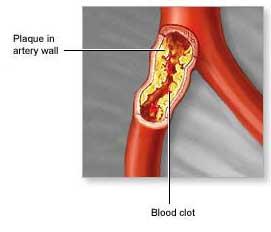
September 2, 2010 - Women and men with a 10-year cardiovascular disease risk of 5 percent or more and normal cholesterol levels but high levels of hsCRP, a protein associated with inflammation, could reduce their risk substantially with statin therapy, according to new research.
The study, published in Circulation: Cardiovascular Quality and Outcomes, an American Heart Association journal, is a new analysis of data from the randomized, placebo-controlled, double blind Justification for Use of statins in Prevention: an Intervention Trial Evaluating Rosuvastatin (JUPITER). The study included men age 50 or older and women age 60 or older.
For patients with elevated high sensitivity C-reactive protein (hsCRP) – a protein associated with systemic inflammation – the study found that taking cholesterol-lowering statin drugs could:
• Reduce the relative risk of cardiovascular disease (CVD) by 45 percent for people estimated to have a 10-year CVD risk of 5 percent to 10 percent; and
• Reduce the relative risk by 49 percent among those with an estimated 11 percent to 20 percent 10-year risk.
"These data demonstrate that women and men with elevated hsCRP who are otherwise at 5 percent to 20 percent 10-year risk had substantive risk reductions with statin therapy even though they are currently outside United States treatment guidelines," said Paul Ridker, M.D., lead study author and director of the Center for Cardiovascular Disease Prevention at Brigham and Women's Hospital, Boston. Ridker is also principal investigator of JUPITER.
People with a 10-year risk of less than 5 percent did not have a statistically significant reduction in events with statins.
He said recent changes in Canadian prevention guidelines prompted a need to better define CVD risk. The new Canadian recommendations call for statin therapy for patients who have "intermediate risk" – defined as 10 percent to 19 percent 10-year risk – and elevated hsCRP, even if their cholesterol levels are in the normal range (i.e. LDL-cholesterol below 130 mg/dL).
"The new Canadian guidelines are a major step forward for prevention and incorporate hsCRP in a thoughtful manner," Ridker said. "However, intermediate risk was defined in the Canadian guidelines as 10 to 20 percent 10-year risk, yet we observed major benefits of statin therapy for those with risks of 5 to 10 percent as well." He added that many physicians incorrectly consider a 5 percent to 10 percent risk score to be "low-risk," especially in women who tend to develop CVD at least a decade later than men, although heart and blood vessel disease remains the number one killer of women and men.
Risk is calculated with screening tools, such as the Framingham Risk Score, which predicts CVD risk based on traditional risk factors such as age, gender, smoking, blood pressure and cholesterol; or the Reynolds Risk Score which also considers hsCRP and parental history of premature heart disease.
The current study finds that although men and women in the 5 percent to 10 percent Framingham 10-year risk group get equal benefit from statin therapy, more women tend to be in the 5 percent to 10 percent risk group while men tend to be in the 11 to 20 percent group.
These data also support the current position taken by the American Heart Association and the U.S. Centers for Disease Control that hsCRP testing is best used in people with intermediate risk to help doctors in their treatment decisions. Statins are known to reduce levels of both cholesterol and hsCRP. In addition, he said statin therapy is no substitute for a healthy diet, smoking cessation and exercise.
"This analysis of the JUPITER study provides important information indicating the groups of men and women who have high CRP and normal LDL-cholesterol that could benefit from statin treatment," said Pamela Ouyang, M.D., professor of medicine at Johns Hopkins University and an American Heart Association volunteer. "The statin used in the JUPITER study was rosuvastatin at a dose of 20 mg. The degree of lowering in risk that would be obtained using lower doses or less potent statin therapy is not known."
For more information: www.americanheart.org, corporatefunding


 April 24, 2024
April 24, 2024 








